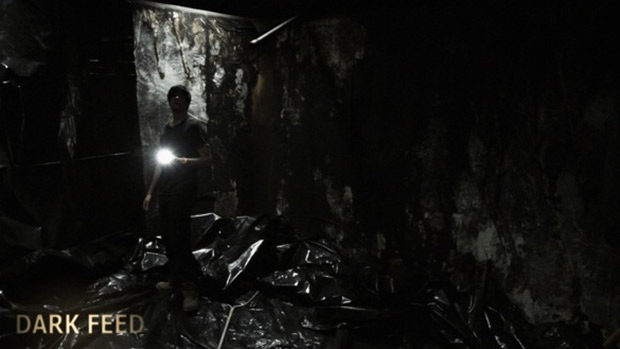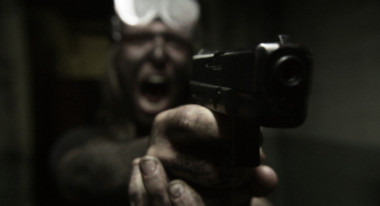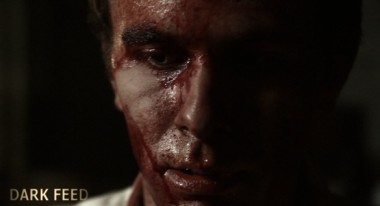 Back to selection
Back to selection
Production, Post-Production and Lessons Learned: Shooting the Low-Budget Horror Movie Dark Feed, Part Two

In part two of our interview with brothers Michael and Shawn Rasmussen, the writers and directors of Dark Feed, they talk about the lessons learned during the production and post-production of a low-budget movie.
Filmmaker: How large was the crew for the Dark Feed shoot, and how many days of shooting were there?
Michael: There was Shawn and I, and we had two sound people – one to hold the boom and one to work the recorder – and a d.p. to also run camera. We had people come in and do other jobs like set building, but on a given day it was usually five people running around the building with the cast, and doing everything.
When we talk about the number of days, it’s hard to say when we stopped shooting because we were such a small crew we could go in and shoot a bit on any off-day. It was probably about a 30-day shoot.
Filmmaker: What were you using for lenses on the 7D?
Michael: A nice zoom, a Tamron that goes from 17 to 50mm, which is really helpful. I also have a Canon 50mm f/1.2 that you can really open wide and get a lot of low light.
Shawn: We’re not using cine lenses, we’re using the standard photographic lenses. Our philosophy really is – until we have a little bit more money to make a bigger movie – use what we have and what we can afford.
Filmmaker: What were you doing for lighting?
Michael: The building had these really cool, old fluorescent bulbs that had a yellow tint to them and it looked really awesome. We were really excited, and we went in with the camera and put some actors beneath the lights to play with it and noticed that they flickered and caused this horrible banding with the camera. We had to go to Home Depot and get a bunch of shop lights. We were running around the hospital with those lights.
I had a few LED lights, but nothing really fancy. It was a really simple kit. I think it’s all about keeping it as simple as possible.
Filmmaker: What about post-production? Who was editing it?
Michael: I was editing it and doing the special effects. We really were doing everything.
We had an editor lined up, but things didn’t work out and we decided that if we wanted to get it done in a reasonable amount of time it would be best for us to edit it ourselves.
I had to sit down and learn Final Cut Pro 7 and After Effects from scratch, and that’s truly how we’ve done everything. It’s great for the next film because now I know how to do the effects and how to do the editing.
Filmmaker: How long a period did it take to edit it?
Michael: Was it a year to get it to where we wanted it to be? We kind of joked that with a film, the less money you have in production the longer your post-production is going to be. We spent a lot of time in post fixing things and doing a lot of polishing because you’re not able to do that stuff on set.
On the new one, we’re doing a fair amount of post work, but we’re not spending as much time because I think we learned a lot of things not to do while making Dark Feed.
Filmmaker: Did you reshoot anything during post-production?
Michael: With the camera being so small and convenient, it’s kind of a curse because I’d be sitting in the editing suite and thinking, “Gee, I wish I had a cut away to somebody’s hand doing this or that,” and we’d go down to the basement – which we used as a double for the hospital – and do a cut-away.
Shawn: In terms of making a microbudget or a small budget movie like this, I think another thing that’s really important is having people around you that buy in to the philosophy of “How can we make this movie with no money?” We were really fortunate that our d.p. bought into the idea of shooting things this way.
It was just so cool that we could go to Home Depot and buy all this material and from that our set builders actually built a lot of the sets in the movie, like the hydrotherapy room, and the morgue.
The only way we could do that was that everybody bought in to the idea of, “We’re trying to do what we can with nothing.”
Filmmaker: What are two things you decided to do differently on the next project?
Michael: After Dark Feed we went out and bought our own sound equipment. We were relying on rentals for sound equipment and sometimes we didn’t get the best gear, or the quality of the sound didn’t match, so we own our sound equipment now.
Shawn: I think it’s really important that you own. Rentals are so expensive nowadays and there certainly is equivalent technology that you can get for about the same amount as renting. It gives you a lot of freedom to do whatever you want once you own the equipment.
Michael: One of the mistakes we made with Dark Feed was that when we were done with the filming we just cleared out of there. As I started learning After Effects, I realized how important it is to get plate shots; photographs of the set that you could then incorporate into an effects shot. On the latest project, every time we finished a shot we would have someone with a camera go through the set and photograph it. It sounds silly, but just the basic walls and stuff so that you can use them in After Effects.
And I would add, make sure you have a lot of coverage.
Shawn: There were two things on the current project I know we changed based on making Dark Feed. One is that we had somebody, while we were shooting, actually syncing up sound and video and making a cut of the movie as we were shooting. That has saved us a tremendous amount of time on this project. The other thing, our cast on Dark Feed was 15 to 20 actors, and it’s really hard on a no-budget movie to be juggling that big a cast along with the crew and other things. If you’re making something really small, limit the number of actors.
Michael: Most of the things were done in the script phase. After Dark Feed, which took place in this sprawling hospital, we sat down to write the new script and said; it’s got to be a location we had, which is this old house, it’s something we can always have access to, and two characters. We scaled down our scope in the script.
Filmmaker: You’re shooting this now?
Michael: We finished shooting it in January, and we’re now editing it.
Filmmaker: You shot Dark Feed on the Canon 7D. Did you use that for the next one as well?
Michael: Yeah, we’ve used it on both films. I feel like the picture quality is really good, I like it. I know it’s not 4K or anything like the RED, but I think it’s good enough for our films.
Filmmaker: Clearly the experience with Dark Feed didn’t discourage you.
Michael: No, it definitely didn’t discourage us. It was hard at the time, it’s taxing making a movie, it’s an endurance test. You’re sitting there and everything is going wrong, and it’s like, “I’m never going to do this again,” but when it’s over you’re like, “That wasn’t so bad, I could do this one more time.”
And while it’s still fresh in your mind, you want to get out there and – having learned what you did wrong last time – make the next one before you forget. And I think we’re going to do that yet again; we have another idea we’re developing right now.
Shawn: At some point, you just have to go out and do it. You’re never going to do it if you don’t just say “Alright, I’m going to go out and do this thing.”
Michael: We made little mistakes along the way, but at least you’re trying to do it. There’s nothing so big that’s going to completely kill the project, so as long as you’re getting stuff shot it’s okay.
I think it helps to have a certain naivete.
Part 1: The Rasmussen Brothers on Shooting the Low-Budget Horror Movie Dark Feed, Part One
Dark Feed


